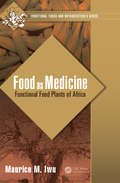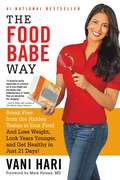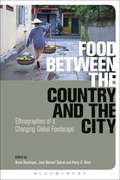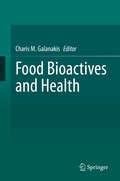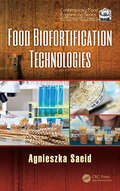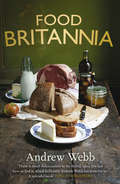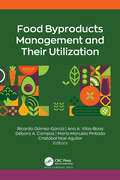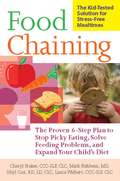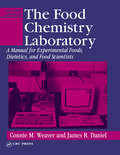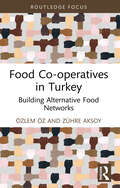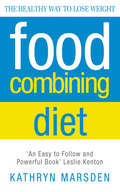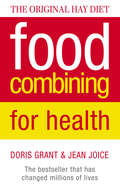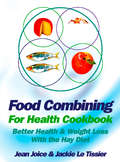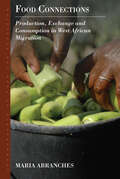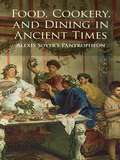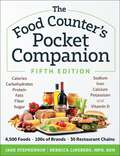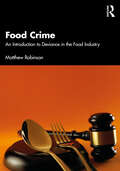- Table View
- List View
Food as Medicine: Functional Food Plants of Africa (Functional Foods and Nutraceuticals)
by Maurice M. IwuThis comprehensive book documents African plants used for functional and medicinal foods. It contains more than 60 detailed monographs of African foods, describing foods with various characteristics such as prebiotic, probiotic, satiety, immune modulation, stress-reduction, sports performance, mental acuity, sleep-supporting, metabolic syndrome, antioxidant, and unsaturated fats. Plant description, botanical names and synonyms, plant part used, habitat and distribution, folk use, nutritional content, and chemistry are all fully detailed. The book highlights indigenous African food processing technologies up to the modern era.
The Food Babe Way: Break Free from the Hidden Toxins in Your Food and Lose Weight, Look Years Younger, and Get Healthy in Just 21 Days!
by Vani HariA #1 national bestseller. Cut hidden food toxins, lose weight, and get healthy in just 21 days. Did you know that your fast food fries contain a chemical used in Silly Putty? Or that a juicy peach sprayed heavily with pesticides could be triggering your body to store fat? When we go to the supermarket, we trust that all our groceries are safe to eat. But much of what we're putting into our bodies is either tainted with chemicals or processed in a way that makes us gain weight, feel sick, and age before our time. Luckily, Vani Hari -- aka the Food Babe -- has got your back. A food activist who has courageously put the heat on big food companies to disclose ingredients and remove toxic additives from their products, Hari has made it her life's mission to educate the world about how to live a clean, organic, healthy lifestyle in an overprocessed, contaminated-food world, and how to look and feel fabulous while doing it. In The Food Babe Way, Hari invites you to follow an easy and accessible plan to rid your body of toxins, lose weight without counting calories, and restore your natural glow in just 21 days. Including anecdotes of her own transformation along with easy-to-follow shopping lists, meal plans, and mouthwatering recipes, The Food Babe Way will empower you to change your food, change your body, and change the world.
Food Between the Country and the City: Ethnographies of a Changing Global Foodscape
by Nuno Domingos José Manuel Sobral Harry G. WestAt a time when the relationship between 'the country' and 'the city' is in flux worldwide, the value and meanings of food associated with both places continue to be debated. Building upon the foundation of Raymond Williams' classic work, The Country and the City, this volume examines how conceptions of the country and the city invoked in relation to food not only reflect their changing relationship but have also been used to alter the very dynamics through which countryside and cities, and the food grown and eaten within them, are produced and sustained. Leading scholars in the study of food offer ethnographic studies of peasant homesteads, family farms, community gardens, state food industries, transnational supermarkets, planning offices, tourist boards, and government ministries in locales across the globe. This fascinating collection provides vital new insight into the contested dynamics of food and will be key reading for upper-level students and scholars of food studies, anthropology, history and geography.
Food Between the Country and the City: Ethnographies of a Changing Global Foodscape
by Nuno Domingos José Manuel Sobral Harry G. WestAt a time when the relationship between 'the country' and 'the city' is in flux worldwide, the value and meanings of food associated with both places continue to be debated. Building upon the foundation of Raymond Williams' classic work, The Country and the City, this volume examines how conceptions of the country and the city invoked in relation to food not only reflect their changing relationship but have also been used to alter the very dynamics through which countryside and cities, and the food grown and eaten within them, are produced and sustained. Leading scholars in the study of food offer ethnographic studies of peasant homesteads, family farms, community gardens, state food industries, transnational supermarkets, planning offices, tourist boards, and government ministries in locales across the globe. This fascinating collection provides vital new insight into the contested dynamics of food and will be key reading for upper-level students and scholars of food studies, anthropology, history and geography.
Food Bioactives and Health (Food Bioactive Ingredients Ser.)
by Charis M. GalanakisBioactive natural compounds have gained attention in recent years due to their potential health benefits, including reducing the risk of diabetes, cancer, and cardiovascular diseases. These benefits derive from bioactive compounds' anti-tumor, anti-inflammatory, anti-oxidative, anti-hypertensive and anti-hyperlipidemic activities, which serve in addition to their basic nutritional functions. Over the last decade, researchers have investigated the health impact of bioactive compounds in detail, and the development of food applications has attracted great interest. Consumer demand has surged for functional foods (nutraceuticals), superfoods, and tailor-made foods, generated by supplementing traditional food products with bioactive ingredients. Food Bioactives and Health offers comprehensive coverage of the properties and health effects of food bioactives in view of new trends in processing, food science and food technology. Starting with the metabolic characteristics of polyphenols, glucosinolates, and other food bioactives, the text then dives into their impact on human health and recent applications in the world of food technology. For food scientists, food technologists, and product developers looking to understand the role of food bioactives in health and develop applications in personalized nutrition, functional foods and nutraceuticals, Food Bioactives and Health serves as a one-stop reference.
Food Biofortification Technologies (Contemporary Food Engineering)
by Agnieszka SaeidBiofortification, which can be defined as the process of increasing the content/density of essential nutrients and/or its bioavailability of food with valuable compounds, is a promising means of increasing nutrient intakes. Traditional fortification practices in which exogenous nutrients are added to food can increase the content of nutrients but the use of biofortified foods with nutrients also may deliver the compounds in a more available form, as well as boost the overall relative effectiveness of these foods in raising nutrients status. Food Biofortification Technologies presents the state of the art in the field of novel methods of fortification and agricultural treatments as a way to improve the quality of obtained food products or compounds enriched with valuable nutrients. The book deals with fortification methods and agricultural treatments, which can improve the quality of food products or other agricultural compounds, providing them with a higher density of valuable nutrients. The utilization of novel products, such as feed additives and fertilizers, can avert nutrients depletion in food products. The book describes new and conventional methods of introducing valuable compounds into food components and presents the application of biosorption, bioaccumulation, and utilization of fertilizers in obtaining designer food. Attention is paid to the use of biomass as the carrier of nutrients such as microelements into the food components. The chapters are dedicated to specific food products and their nutrient components. The first chapter discusses the agronomic biofortification with micronutrients where the fertilization strategies are pointed out as a key to plant/cereals fortification. Other chapters present the fortification of animal foodstuffs such as meat, fish, milk, and eggs as well as the fortification of plant foodstuffs such as vegetables, fruits, and cereals. The book also explores advances in food fortification with vitamins and co-vitamins, essential minerals, essential fatty and amino acids, phytonutrients, and enzymes.
Food Biofortification Technologies (Contemporary Food Engineering)
by Agnieszka SaeidBiofortification, which can be defined as the process of increasing the content/density of essential nutrients and/or its bioavailability of food with valuable compounds, is a promising means of increasing nutrient intakes. Traditional fortification practices in which exogenous nutrients are added to food can increase the content of nutrients but the use of biofortified foods with nutrients also may deliver the compounds in a more available form, as well as boost the overall relative effectiveness of these foods in raising nutrients status. Food Biofortification Technologies presents the state of the art in the field of novel methods of fortification and agricultural treatments as a way to improve the quality of obtained food products or compounds enriched with valuable nutrients. The book deals with fortification methods and agricultural treatments, which can improve the quality of food products or other agricultural compounds, providing them with a higher density of valuable nutrients. The utilization of novel products, such as feed additives and fertilizers, can avert nutrients depletion in food products. The book describes new and conventional methods of introducing valuable compounds into food components and presents the application of biosorption, bioaccumulation, and utilization of fertilizers in obtaining designer food. Attention is paid to the use of biomass as the carrier of nutrients such as microelements into the food components. The chapters are dedicated to specific food products and their nutrient components. The first chapter discusses the agronomic biofortification with micronutrients where the fertilization strategies are pointed out as a key to plant/cereals fortification. Other chapters present the fortification of animal foodstuffs such as meat, fish, milk, and eggs as well as the fortification of plant foodstuffs such as vegetables, fruits, and cereals. The book also explores advances in food fortification with vitamins and co-vitamins, essential minerals, essential fatty and amino acids, phytonutrients, and enzymes.
Food Britannia
by Andrew WebbBritish food has not traditionally been regarded as one of the world's great cuisines, and yet Stilton cheese, Scottish raspberries, Goosnargh duck and Welsh lamb are internationally renowned and celebrated. And then there are all those dishes and recipes that inspire passionate loyalty among the initiated: Whitby lemon buns and banoffi pie, for example; pan haggerty and Henderson's relish. All are as integral a part of the country's landscape as green fields, rolling hills and rocky coastline. In Food Britannia, Andrew Webb travels the country to bring together a treasury of regional dishes, traditional recipes, outstanding ingredients and heroic local producers. He investigates the history of saffron farming in the UK, tastes the first whisky to be produced in Wales for one hundred years, and tracks down the New Forest's foremost expert on wild mushrooms. And along the way, he uncovers some historical surprises about our national cuisine. Did you know, for example, that the method for making clotted cream, that stalwart of the cream tea, was probably introduced from the Middle East? Or that our very own fish and chips may have started life as a Jewish-Portuguese dish? Or that Alfred Bird invented his famous custard powder because his wife couldn't eat eggs?The result is a rich and kaleidoscopic survey of a remarkably vibrant food scene, steeped in history but full of fresh ideas for the future: proof, if proof were needed, that British food has come of age.
Food Byproducts Management and Their Utilization
by Ricardo García Ana A. Vilas-Boas Débora A. Campos Maria Manuela Pintado Cristóbal Noé AguilarFood byproducts derived from industrial processing is a serious worldwide problem because it generates environmental pollution and results in significant food and economic losses from food waste. This new volume shows how food byproducts can be value-added renewable sources with the application of novel biotechnologies that avoid hazardous chemicals. The volume discusses the importance of valorizing food wastes and illustrates their value-added properties for industry. It explains the significant progress in bioresources processing for compound extraction and production as well as the increasing interest of food ingredients development, in which health care, environment, and economics play an essential part in biotechnological research. It considers the waste byproducts of various crops, such as tomato, melon, maize, berries, soybean, coffee, and their uses in the generation of health-benefiting bioactive compounds. The volume goes on to explore the various biotechnological strategies to extract, produce, and recover bioactive compounds along with the cost-effectiveness of these methods. Key features: Describes technological aspects in consolidated processing and bioprocessing of food by-products Discusses technological aspects in biotechnology for food byproducts treatment and the richness of their biomolecules Looks at the nutraceutical and health benefit aspects of such biomolecules from food waste byproducts Provides attractive and sustainable methodologies for bioproduct extraction and recovery for industrial application This volume, Food Byproducts Management and Their Utilization, presents strategies that are of interest in food engineering, green chemistry, biotechnology, and some other areas, while paying special attention to biorefinery approaches and new challenges that industries are dealing with in the era of sustainable development. It aims to encourage not only researchers but also governmental and enterprise sectors to recognize the value and applications of food byproducts and waste.
Food Byproducts Management and Their Utilization
by Ricardo Gómez-García Ana A. Vilas-Boas Débora A. Campos Maria Manuela Pintado Cristóbal Noé AguilarFood byproducts derived from industrial processing is a serious worldwide problem because it generates environmental pollution and results in significant food and economic losses from food waste. This new volume shows how food byproducts can be value-added renewable sources with the application of novel biotechnologies that avoid hazardous chemicals. The volume discusses the importance of valorizing food wastes and illustrates their value-added properties for industry. It explains the significant progress in bioresources processing for compound extraction and production as well as the increasing interest of food ingredients development, in which health care, environment, and economics play an essential part in biotechnological research. It considers the waste byproducts of various crops, such as tomato, melon, maize, berries, soybean, coffee, and their uses in the generation of health-benefiting bioactive compounds. The volume goes on to explore the various biotechnological strategies to extract, produce, and recover bioactive compounds along with the cost-effectiveness of these methods. Key features: Describes technological aspects in consolidated processing and bioprocessing of food by-products Discusses technological aspects in biotechnology for food byproducts treatment and the richness of their biomolecules Looks at the nutraceutical and health benefit aspects of such biomolecules from food waste byproducts Provides attractive and sustainable methodologies for bioproduct extraction and recovery for industrial application This volume, Food Byproducts Management and Their Utilization, presents strategies that are of interest in food engineering, green chemistry, biotechnology, and some other areas, while paying special attention to biorefinery approaches and new challenges that industries are dealing with in the era of sustainable development. It aims to encourage not only researchers but also governmental and enterprise sectors to recognize the value and applications of food byproducts and waste.
Food Chaining: The Proven 6-Step Plan to Stop Picky Eating, Solve Feeding Problems, and Expand Your Child's Diet
by Cheri Fraker Dr. Mark Fishbein Sibyl Cox Laura WalbertThe complete guide for parents of picky eaters -- how to end mealtime meltdowns and get your children the nutrition they needDoes your child regularly refuse foods or throw a fit at mealtimes? Are you concerned she isn't getting enough nutrition, or that that your child's pickiness might be caused by a hidden medical issue? For every frustrated parent, the food chaining method offers a medically-proven, kid-tested solution.Developed by a team of internationally known medical experts, Food Chaining helps you identify the reasons behind your child's picky eating habits -- be it medical, sensory, or because of allergies. Then, with a simple, 6-step method centered around taste, temperature, and texture, target foods are selected that are similar to the ones your child likes, gradually expanding to all food groups. Does your kid like French fries but won't touch veggies? Try hash browns, and slowly expand to sweet potato fries and zucchini sticks -- and then work your way to steamed vegetables.With helpful information about common food allergies, lists of sample food chains, advice for special needs children, as well as a pre-chaining program to prevent food aversions before they develop, Food Chaining is your guide to raising lifelong health eaters.
Food Chaining: The Proven 6-Step Plan to Stop Picky Eating, Solve Feeding Problems, and Expand Your Child's Diet
by Cheri Fraker Dr. Mark Fishbein Sibyl Cox Laura WalbertThe complete guide for parents of picky eaters -- how to end mealtime meltdowns and get your children the nutrition they need Does your child regularly refuse foods or throw a fit at mealtimes? Are you concerned she isn't getting enough nutrition, or that that your child's pickiness might be caused by a hidden medical issue? For every frustrated parent, the food chaining method offers a medically-proven, kid-tested solution. Developed by a team of internationally known medical experts, Food Chaining helps you identify the reasons behind your child's picky eating habits -- be it medical, sensory, or because of allergies. Then, with a simple, 6-step method centered around taste, temperature, and texture, target foods are selected that are similar to the ones your child likes, gradually expanding to all food groups. Does your kid like French fries but won't touch veggies? Try hash browns, and slowly expand to sweet potato fries and zucchini sticks -- and then work your way to steamed vegetables. With helpful information about common food allergies, lists of sample food chains, advice for special needs children, as well as a pre-chaining program to prevent food aversions before they develop, Food Chaining is your guide to raising lifelong health eaters.
The Food Chemistry Laboratory: A Manual for Experimental Foods, Dietetics, and Food Scientists, Second Edition (Contemporary Food Science Ser.)
by Connie M. Weaver James R. DanielA popular book in its first edition, The Food Chemistry Laboratory: A Manual for Experimental Foods, Dietetics, and Food Scientists, Second Edition continues to provide students with practical knowledge of the fundamentals of designing, executing, and reporting the results of a research project. Presenting experiments that can be completed, in many
Food Co-operatives in Turkey: Building Alternative Food Networks (Routledge Focus on Environment and Sustainability)
by Özlem Öz Zühre AksoyThis book addresses the roles played by food co-operatives in the attempt to build alternative food networks, drawing on an in-depth analysis of case studies in Turkey. While many existing studies focus on food co-operatives and alternative food networks in the Global North, this book provides an important insight into a country from the Global South and, in doing so, not only provides a novel perspective but also challenges the rigid North–South categorization. The book provides a rounded view by examining both a producer and a consumer co-operative: BÜKOOP is a university-based consumer food co-operative, and the Vakıflı co-operative is a food-producing co-operative located in the Hatay province on the Mediterranean coast of Turkey. These two co-operatives, which have been working together for more than ten years, share the dream of establishing a network of co-operatives, in which producers exist in solidarity with consumers, blurring the dichotomy of producer versus consumer as well as rural versus urban. In addition to contributing towards a better understanding of the urban–rural divide, within the framework of alternative food networks, the in-depth analysis of these two cases enables us to explore how food co-operatives develop and how they keep their commitment to their original goals and ideals so as to help build an alternative food system. The lessons we learn from these two working case examples highlight the successes and areas of improvement for food co-operatives. They also provide evidence against the pessimism about alternative food networks by demonstrating that co-operatives can democratize both production and consumption. This book will be of interest to students and scholars studying alternative food networks, food justice, food sovereignty, transformation towards sustainable food systems, social movements, and the urban–rural divide.
Food Co-operatives in Turkey: Building Alternative Food Networks (Routledge Focus on Environment and Sustainability)
by Özlem Öz Zühre AksoyThis book addresses the roles played by food co-operatives in the attempt to build alternative food networks, drawing on an in-depth analysis of case studies in Turkey. While many existing studies focus on food co-operatives and alternative food networks in the Global North, this book provides an important insight into a country from the Global South and, in doing so, not only provides a novel perspective but also challenges the rigid North–South categorization. The book provides a rounded view by examining both a producer and a consumer co-operative: BÜKOOP is a university-based consumer food co-operative, and the Vakıflı co-operative is a food-producing co-operative located in the Hatay province on the Mediterranean coast of Turkey. These two co-operatives, which have been working together for more than ten years, share the dream of establishing a network of co-operatives, in which producers exist in solidarity with consumers, blurring the dichotomy of producer versus consumer as well as rural versus urban. In addition to contributing towards a better understanding of the urban–rural divide, within the framework of alternative food networks, the in-depth analysis of these two cases enables us to explore how food co-operatives develop and how they keep their commitment to their original goals and ideals so as to help build an alternative food system. The lessons we learn from these two working case examples highlight the successes and areas of improvement for food co-operatives. They also provide evidence against the pessimism about alternative food networks by demonstrating that co-operatives can democratize both production and consumption. This book will be of interest to students and scholars studying alternative food networks, food justice, food sovereignty, transformation towards sustainable food systems, social movements, and the urban–rural divide.
Food Combining: Lose Weight with Food Combinations that Work for Your Body (Wellbeing Quick Guides)
by Liz EarleLiz Earle explains the science behind food combining and shows you how smart combinations can improve digestion and nutrition, promote weight loss and help you to feel great.Bestselling beauty and wellbeing writer Liz Earle's fully revised and updated quick guide to the principles of food combining, including:- The science behind food combining and how separating protein and carbohydrates can improve digestion and boost weight loss- A guide to the food groups, including information about acid and alkaline-forming foods- Tips and advice on how to incorporate the principles of food combining into your everyday life - Delicious recipes including Lemon Chicken, Prawn Kebabs with Herb Dressing, and Spiced Bananas
Food Combining Diet: The Healthy Way To Lose Weight
by Kathryn MarsdenThis bestselling weight loss title has sold over 250,000 copies. Adapting Dr Hay’s teachings – separating protein and starch for optimum health – respected nutritionist Kathryn Marsden provides advice and easy recipes to help you lose weight easily, naturally, safely and healthily.
Food Combining for Health: The Bestseller That Has Changed Millions Of Lives
by Doris Grant Jean JoiceThe international best-selling guide to how the Hay diet (food combining) can improve health and vitality. With over one million copies sold worldwide, this is the ultimate guide to the health benefits of food combining from two of the most respected authors in the field.
Food Combining for Health Cookbook: Better Health And Weight Loss With The Hay Diet
by Jean Joice Jackie Le TissierFrom the best selling authors of Food Combining for Health and Food Combining For Vegetarians and with a foreword by Doris Grant – the Food Combining for Health Cookbook is the definitive recipe collection and nutrition guide for food combiners.
Food Connections: Production, Exchange and Consumption in West African Migration (Anthropology of Food & Nutrition #10)
by Maria AbranchesFood Connections follows the movement of food from its production sites in West Africa to its final spaces of consumption in Europe. It is an ethnographic study of economic and social life amongst a close-knit community of food producers, traders and consumers and a wide range of small intermediaries that operate in Guinea-Bissau and Portugal. By investigating the way meanings of food and land are embedded in everyday experiences and relationships in the various phases of the movement, on both sides of the migration, it reveals the connections that transnational processes of food production, exchange and consumption generate between two lifeworlds.
Food Connections: Production, Exchange and Consumption in West African Migration (Anthropology of Food & Nutrition #10)
by Maria AbranchesFood Connections follows the movement of food from its production sites in West Africa to its final spaces of consumption in Europe. It is an ethnographic study of economic and social life amongst a close-knit community of food producers, traders and consumers and a wide range of small intermediaries that operate in Guinea-Bissau and Portugal. By investigating the way meanings of food and land are embedded in everyday experiences and relationships in the various phases of the movement, on both sides of the migration, it reveals the connections that transnational processes of food production, exchange and consumption generate between two lifeworlds.
Food, Cookery, and Dining in Ancient Times: Alexis Soyer's Pantropheon
by Alexis Soyer"Tell me what thou eatest," Alexis Soyer declared in a familiar refrain, "and I will tell thee who thou art." In his book Pantropheon, originally published in 1853, the flamboyant Frenchman (and world's first celebrity chef) ventures to answer that question as he presents a wealth of entertaining and enlightening information on what food the people of ancient civilizations ate and how they prepared it.Describing the culinary achievements of the Greeks, Romans, Assyrians, Egyptians, and Jews, Soyer covers such topics as the mythological origin of specific foods (pomegranates and eels, for example); agricultural, milling, and marketing practices; descriptions of seasonings, pastries, and exotic dishes; the treatment of dinner guests; as well as suggestions for serving pigeon, peacock, wild boar, camel, elephant, flamingo, and other wildlife.Enhanced by 38 illustrations depicting food-related objects and antiquity's gastronomic wonders, this witty and literal study of epicurean delights will charm history buffs and food enthusiasts alike.
The Food Counter's Pocket Companion, Fifth Edition: Calories, Carbohydrates, Protein, Fats, Fiber, Sugar, Sodium, Iron, Calcium, Potassium, and Vitamin D
by Jane Stephenson Rebecca LindbergAn updated edition of a handy pocket nutrition guide for easily checking the nutrient values of over 4,500 foods, 100s of brands, and 30 fast food restaurant chains—with over 100,000 total copies of previous editions sold
Food Crime: An Introduction to Deviance in the Food Industry
by Matthew RobinsonThis book addresses the various forms of deviance and criminality found within the conventional food system. This system—made up of numerous producers, processors, distributors, and retailers of food—has significant, far-reaching consequences bearing upon the environment and society.Food Crime broadly outlines the processes and impacts of this food system most relevant for the academic discipline of criminology, with a focus on the negative health outcomes of the US diet (e.g., obesity and diabetes) and negative outcomes associated with the system itself (e.g., environmental degradation). The author introduces the concept of "food criminology," a new branch of criminology dedicated to the study of deviance in the food industry. Demonstrating the deviance and criminality involved in many parts of the conventional food system, this book is the first to provide exhaustive coverage of the major issues related to what can be considered food crime. Embedded in the context of state-corporate criminality, the concepts and practices exposed in this book bring attention to harms associated with the conventional food system and illustrate the degree of culpability of food companies and government agencies for these harms.This book is of interest to students, scholars, and practitioners seeking a more just and healthy food system and encourages further future research into food crimes in the disciplines of criminology, criminal justice, and sociology.
Food Crime: An Introduction to Deviance in the Food Industry
by Matthew RobinsonThis book addresses the various forms of deviance and criminality found within the conventional food system. This system—made up of numerous producers, processors, distributors, and retailers of food—has significant, far-reaching consequences bearing upon the environment and society.Food Crime broadly outlines the processes and impacts of this food system most relevant for the academic discipline of criminology, with a focus on the negative health outcomes of the US diet (e.g., obesity and diabetes) and negative outcomes associated with the system itself (e.g., environmental degradation). The author introduces the concept of "food criminology," a new branch of criminology dedicated to the study of deviance in the food industry. Demonstrating the deviance and criminality involved in many parts of the conventional food system, this book is the first to provide exhaustive coverage of the major issues related to what can be considered food crime. Embedded in the context of state-corporate criminality, the concepts and practices exposed in this book bring attention to harms associated with the conventional food system and illustrate the degree of culpability of food companies and government agencies for these harms.This book is of interest to students, scholars, and practitioners seeking a more just and healthy food system and encourages further future research into food crimes in the disciplines of criminology, criminal justice, and sociology.
